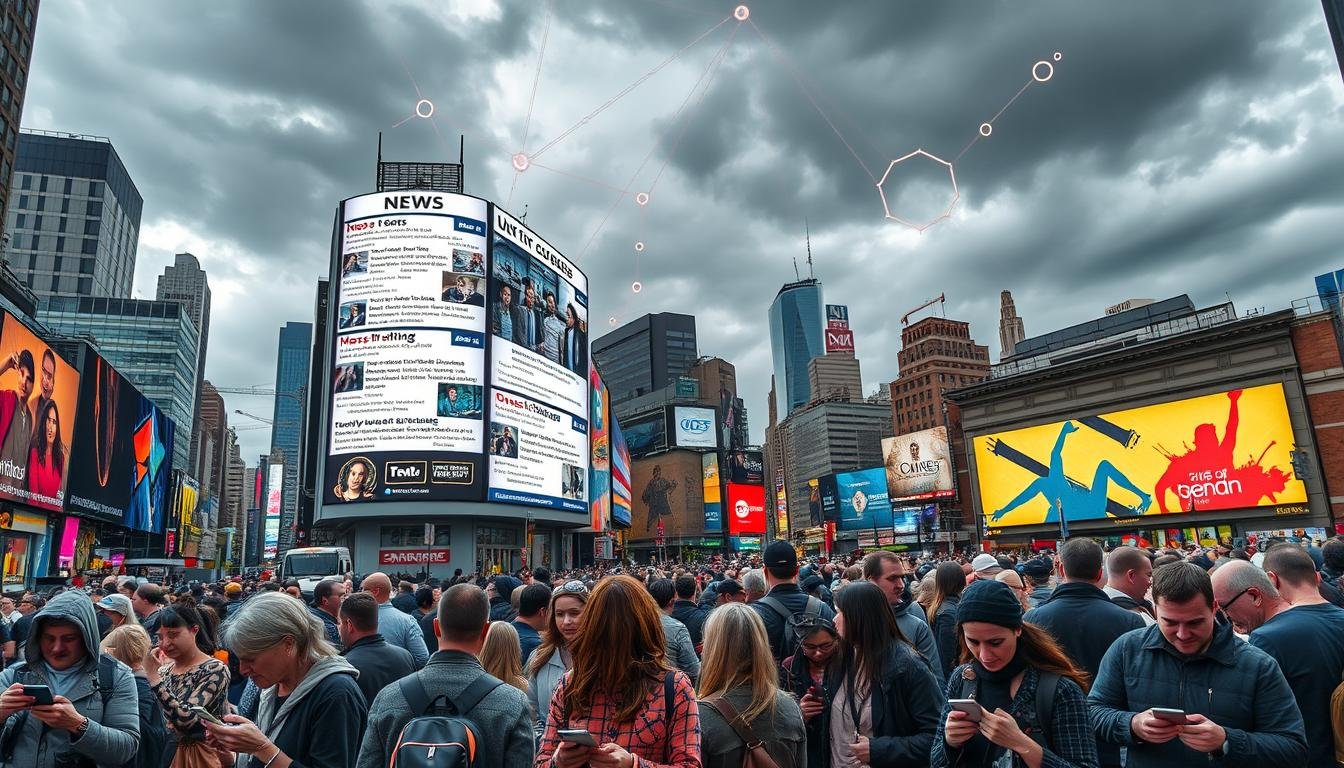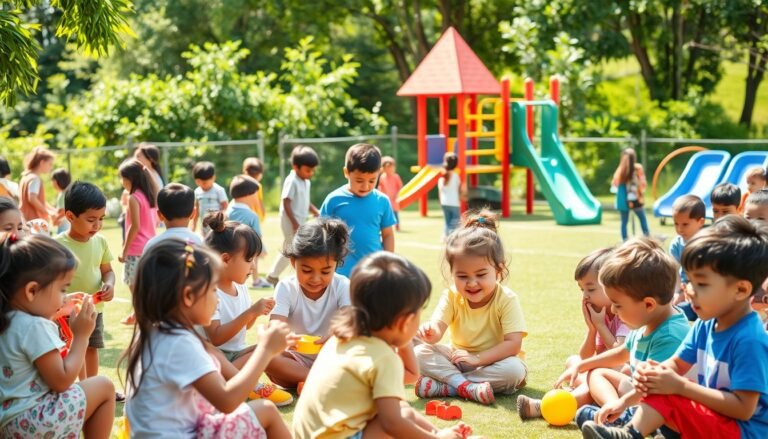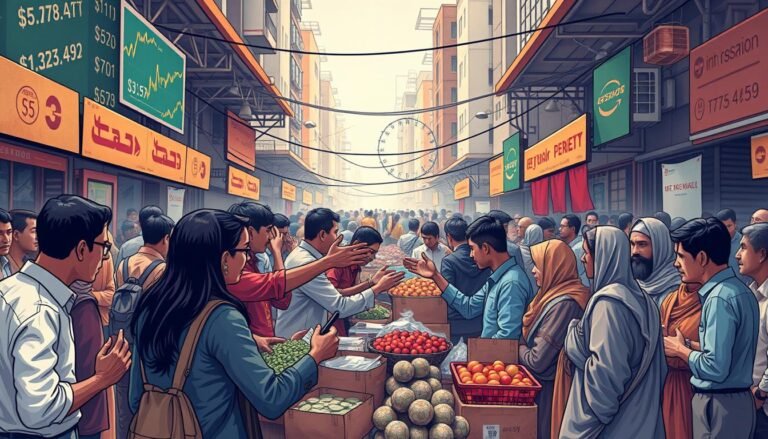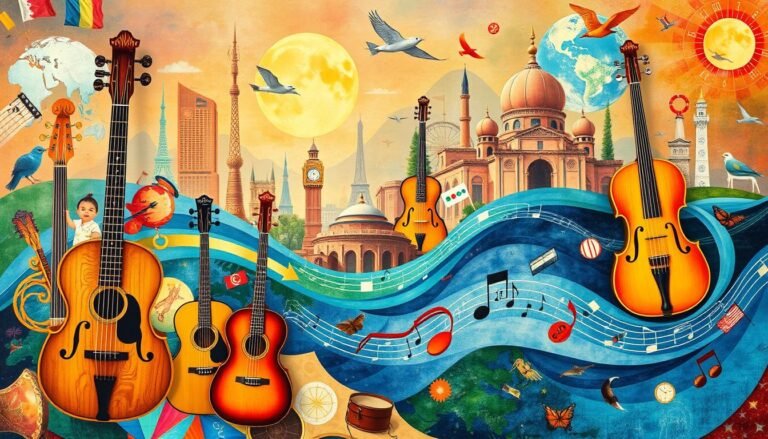The Role of Mass Media in Shaping Public Opinion
Ever thought about how your views on big issues form? It might be more than you think. Mass media has a huge role in shaping what we think about politics, education, and more.
In today’s digital world, we get info from many sources. TV, newspapers, and online platforms all shape our view of the world. This constant info flow deeply affects public opinion, often without us noticing.
Mass communication is more than just sharing facts. It’s about telling stories and setting the agenda. The way media presents stories can change how we see important issues. For example, books like “Silent Spring” and films like “An Inconvenient Truth” have changed how we think about the environment.
Media does more than just report news. It shapes our views on education, religion, and even how we vote. Studies show that media coverage, especially before elections, can make people more likely to vote and support causes.
Key Takeaways
- Mass media greatly affects public opinion on big issues
- Media framing and setting agendas shape our view of events
- News coverage can change how we vote and get involved in politics
- Media also shapes our views on education, religion, and social issues
- It’s important to think critically when consuming media
Understanding Mass Media’s Influence on Society
Mass media has a big impact on what we think and do. It touches many parts of our lives, from news to fun shows. Over time, it has changed with new tech and social changes.
Defining mass media in the modern context
Now, mass media includes TV, newspapers, and the internet. These are key sources of info for billions of people. Thanks to new tech, media can reach us in ways we never thought possible.
The pervasive nature of media in daily life
Media is a big part of our daily lives. We see it from morning news to social media at night. This constant media shapes how we see the world, as explained by cultivation theory.
Historical perspective on media’s evolving role
Research on media started in the 1930s with the Payne Fund studies. These looked at how media affects young people. Now, we study long-term effects and how media shapes our views.
“Some kinds of communication on some kinds of issues have brought to the attention of some kinds of people under some kinds of conditions have some kinds of effects.” – Berelson
It’s important to understand how mass media affects us. By knowing how media works, we can be smarter about what we take in. This helps us deal with the media all around us.
The Agenda-Setting Theory in Mass Communication
The agenda-setting theory is key to how we form opinions. It shows how news coverage shapes what we see as important issues. Media priorities set the stage for what we think matters.
In 1972, Maxwell McCombs and Donald Shaw brought this theory to light. They found a clear link between what’s in the news and what we think is important. Their study showed that more coverage means more public interest.
The theory has three main models:
- Awareness model
- Priorities model
- Salience model
These models explain how media coverage impacts what we know and what we care about. It’s all about making certain topics more accessible in our minds.
“The press may not be successful much of the time in telling people what to think, but it is stunningly successful in telling its readers what to think about.” – Bernard Cohen
Recent events prove the agenda-setting power. During the COVID-19 pandemic, media coverage changed public actions, like wearing masks and distancing. Also, lots of news on climate change has led to talks on renewable energy and cutting pollution.
Some say the theory doesn’t fully consider our personal beliefs and experiences. They believe we’re not just passive listeners but actively pick and choose what to believe. Yet, despite these points, the agenda-setting theory is still vital for understanding how media shapes public opinion.
Media Framing and Its Impact on Public Perception
News framing is key in shaping how we see events and issues. The way media presents information can greatly affect public opinion. This includes topics like education and politics.
The Power of Framing
Research shows that media coverage changes how we view issue importance. More than 70% of people think topics covered often in news are more critical. This shows the media’s power in setting the agenda.
Case Study: Israel-Hamas Conflict Coverage
The recent conflict between Israel and Hamas shows how framing news affects what we think. Western media got criticized for their coverage. For example, the BBC was criticized for calling Hamas “militants” instead of “terrorists,” which could change how we see their actions.
Ethical Implications of Framing Techniques
When we talk about media ethics, framing comes into play. US media often favors Israeli and American government views in the Israel-Hamas conflict. This lack of Palestinian viewpoints raises concerns about fairness in reporting.
| Media Type | Perceived Bias | Public Trust |
|---|---|---|
| Traditional Media | Leans towards government narratives | 43% trust in accurate reporting |
| Social Media | Diverse perspectives, but risk of misinformation | 60% access news through these platforms |
As media framing shapes what we think, it’s important to think critically about news. We should look for diverse sources for a full understanding of events.
The Role of Mass Media in Shaping Public Opinion
Mass media is key in shaping opinions and public talks. Studies show a strong link between media coverage and what people care about. For example, research found a high +0.78 correlation between news magazine coverage and public opinion in the 1960s.
Media influence differs around the world. In Spain, local news matched public concerns at a +0.90 level. The UK saw a +0.54 correlation between international news and public interest from 1990 to 2000.
The media does more than just inform. It can motivate people to act, like voting or supporting causes. In some European countries, TV has turned elections into a battle between leaders.
“Public opinion can be described as the aggregate of beliefs and attitudes expressed by individuals about political objects.”
Various groups shape public opinion. The mass public is the biggest group, while the attentive public closely watches issues. The opinion elite, in powerful positions, make policy decisions. This shows how complex forming opinions is in our media-rich world.
| Public Group | Characteristics | Influence Level |
|---|---|---|
| Mass Public | Largest population (80-85%) | Low |
| Attentive Public | Well-informed, critical | Medium |
| Opinion Elite | Top positions of power | High |
Social Media’s Growing Influence on Public Discourse
Social media has changed how we share and get information. It has become a key player in shaping public opinion worldwide.
The democratization of information sharing
Social media has made sharing information easier. A Pew Research Center study showed that half of U.S. adults get news from these platforms. This has given a voice to many perspectives and spread ideas fast.
Echo chambers and filter bubbles in social networks
Even though social media has made information more accessible, it has also created echo chambers. These online spaces often make people stick to what they believe and limit new ideas. A survey found that 65% of people in 19 countries think the internet and social media have made political divisions worse.
Viral content and its impact on public opinion
Viral content on social media can change public opinion fast. Hashtag campaigns like #MeToo and #BlackLivesMatter have highlighted important issues and forced action. But, this fast spread of information can also have both good and bad effects on how we talk to each other.
“Social media has become a double-edged sword in our society, simultaneously informing and dividing us.”
The impact of social media on public talk is clear. As we use these platforms, we need to be aware of both the good and bad sides of sharing information through viral content.
Media Credibility and Public Trust
Media credibility is key to shaping public opinion. Recent studies show a big drop in trust towards news sources. This change affects how people see and use information, making media outlets less reliable.
A recent survey reveals some shocking facts about media trust in America:
- Only 16% of Americans have high confidence in newspapers
- A mere 11% trust TV news
- 53% express distrust in television news sources
These numbers show a growing doubt towards traditional media. The drop in trust is a big challenge for reliable information and the media’s role in public talk.
The COVID-19 pandemic has made things harder for media credibility. Studies show that trust in media affects how people act to prevent infections. This shows how crucial reliable info is in crises.
“Trust in news media is essential for informed public discourse and decision-making.”
It’s important to fight misinformation and bring back public trust. Media literacy programs and clear reporting can help bridge the gap between news and people. By focusing on accuracy and fairness, media can work to regain trust and help society be better informed.
| Media Type | Trust Level | Distrust Level |
|---|---|---|
| Newspapers | 16% | 84% |
| TV News | 11% | 53% |
The Interplay Between Mass Media and Political Landscapes
Mass media greatly affects political scenes by covering elections and their results. Broadcasting has changed how leaders talk to people, making a big difference in how campaigns work. This change has touched both parliamentary and presidential elections.
Media’s Role in Election Coverage
Election coverage often looks at the “horserace,” focusing on polls and who’s leading. This can change how voters see candidates and shape campaign plans. Pictures of candidates are key, showing their feelings, actions, and trustworthiness.
Political Polarization and Media Consumption
How people use media shows and adds to political divisions. More people getting news from sources that match their political views means deeper political splits. Social media, used by 62% of Americans for news, creates “echo chambers” that limit exposure to different views.
The “Fourth Estate” in Modern Democracy
The idea of media as the “Fourth Estate” is still important today. Groups like PolitiFact and FactCheck.org are key in keeping politicians honest. Media can really change election results, as we’ve seen in recent U.S. primaries.
| Media Type | Impact on Political Landscape | Challenges |
|---|---|---|
| Traditional Media | Shapes public opinion on political issues | Maintaining objectivity in coverage |
| Social Media | Allows direct voter-candidate communication | Echo chambers and misinformation spread |
| Data Analysis Tools | Influences focus on poll numbers and predictions | Overemphasis on “horserace” narrative |
Cultural Shifts and Social Norms: Media’s Transformative Power
Mass media has a big impact on cultural shifts and social norms. It shapes attitudes on many life aspects. From religion to family values, and from international relations to economic views, media molds public opinion.
The media’s cultural influence is hard to spot. It’s a complex process that takes time. Politicians and local influencers use media to spread their ideas. They use symbols and slogans to change people’s views on big issues.
Recent studies show how media can change things. Social broadcast groups have been effective in changing attitudes towards gender equality and violence against women. These groups make people more against domestic violence and encourage community action.
| Impact Area | Social Broadcast | Individual Broadcast |
|---|---|---|
| Rejection of Violence Against Women | Higher | Lower |
| Support for Gender Equality | Stronger | Weaker |
| Willingness to Intervene in Domestic Violence | More Likely | Less Likely |
| Educating Children on Gender Equality | More Inclined | Less Inclined |
Social media is key in shaping politics today. It gives newcomers in politics a way to get support without spending a lot. Young elected officials under 35 are great at using social media to connect with people.
The media also affects social norms through brand messaging. A big 66% of consumers think brands should speak up on social issues. This shows how businesses can shape public opinion through media.
Challenges in the Digital Age: Misinformation and Media Literacy
The digital era has changed how we get information. Now, misinformation spreads fast, affecting public opinion. A 2016 study found that people often look for news that agrees with their beliefs, creating echo chambers.
The spread of fake news and its consequences
Fake news is a big issue today. After the 2016 election, a Pew Research study showed 64% of adults believe fake news causes confusion. Sadly, 23% admitted to sharing false political stories. This misinformation can cause deep divisions in society.
Importance of critical thinking in media consumption
To fight this, we need strong media literacy skills. It’s crucial to think critically about the media we consume. Chris Davey believes universities should teach media literacy as a core subject. This skill is vital for finding truth in our digital world.
Initiatives to promote media literacy education
Universities are key in making society smarter. They can mix online content to show different viewpoints, not just what users like. Journalism education is still popular, training the next generation of truth-seekers. By teaching media literacy, schools can help students become better informed and careful media consumers.
Source Links
- Public opinion – Mass Media, Social Media, Influence
- Student News Service of WCU
- Exploring the Influence of Public Perception of Mass Media Usage and Attitudes towards Mass Media News on Altruistic Behavior
- The Role of Mass Media in Shaping Public Opinion and Cultural Trends
- The Role of Mass Media in Shaping Public Opinion on Culture and National Identity
- Influence of mass media
- Agenda-setting theory
- Agenda Setting Theory | Media’s Role in Shaping Public Opinion
- jcom_330 79..98
- Analyzing the Role of Media in Shaping Public Opinion —
- How Does the Media Impact Public Perception about War?
- The Agenda-Setting Role of the Mass Media
- Icheke Journal of the Faculty of Humanities
- 2. Views of social media and its impacts on society
- Social Media Impact: How Social Media Sites Affect Society
- The Power of Social Media: Shaping Political Discourse in the Digital Age
- How Media Exposure, Media Trust, and Media Bias Perception Influence Public Evaluation of COVID-19 Pandemic in International Metropolises
- Opinion | How to Destroy (What’s Left of) the Mainstream Media’s Credibility (Published 2023)
- Mass media impact on opinion evolution in biased digital environments: a bounded confidence model – Scientific Reports
- Six ways the media influence elections
- How Does Media Influence Social Norms? A Field Experiment on the Role of Common Knowledge.
- The role of social media in shaping political discourse and public opinion in the digital age
- The impact of social media on public opinion – CC Plus
- The Future of Truth and Misinformation Online
- Media Literacy: Navigating the Truth in the Digital Age







